| Article ID | Journal | Published Year | Pages | File Type |
|---|---|---|---|---|
| 5467584 | Nuclear Instruments and Methods in Physics Research Section B: Beam Interactions with Materials and Atoms | 2017 | 6 Pages |
Abstract
α-Al2O3 ceramic coatings were prepared by a novel metal organic decomposition (MOD) method on 316L stainless steel. Effects of electron irradiation and post-irradiation annealing process on the surface morphology, composition, phases and corrosion resistance of the coating were studied by using AFM, FESEM, EDS, XRD and electrochemical workstation. The results show that the surface of α-Al2O3 ceramic coating was roughened after irradiation and then smoothed after subsequent annealing. The oxygen content of the coating was highly decreased after electron irradiation and then increased after subsequent annealing. The FeO phase of the coating was disappeared after irradiation and re-formed with the disappearance of AlFeCr phase after subsequent annealing. Both the irradiated and post-irradiated annealed coatings behaved superior corrosion resistance and protective ability compared to the original counterpart due to microstructure modification induced by irradiation. Meanwhile, two electrical circuit models were proposed to simulate the EIS results to explain the corrosion mechanism of the coatings.
Related Topics
Physical Sciences and Engineering
Materials Science
Surfaces, Coatings and Films
Authors
Long Wang, Ling Dan Zhang, Jia Heng Wang, Yong Jin Feng, Kai Ming Feng, Ji Jun Yang, Jia Li Liao, Yuan You Yang, Ning Liu,
